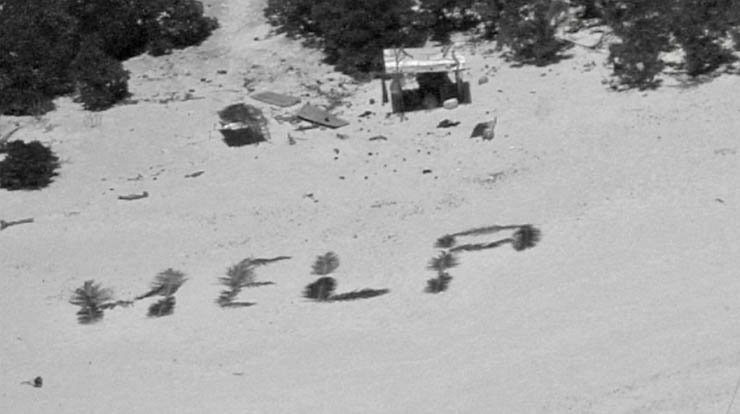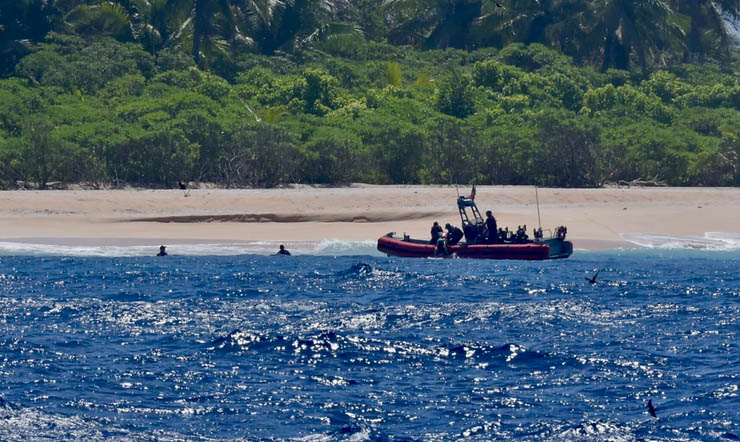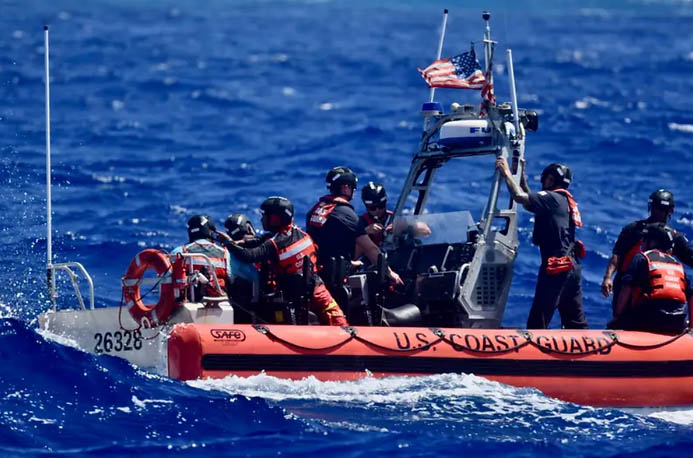The U.S. Coast Guard, with help from the U.S. Navy, rescued three men from a tiny atoll south of Guam on Tuesday in what can only be described as a classic rescue scenario.
The rescue was initiated by a U.S. Navy submarine hunting plane that spotted the words ‘HELP’ written in palm fronds on the beach of a tiny tropical island.
The Navy plane was searching for three sailors who had gone missing the week prior. The men had left the port of Polowatt Atoll in a 20-foot open skiff with an outboard motor on March 31st.
A week later, on April 6, a relative of the three men “reported her three uncles had not returned from Pikelot Atoll,” approximately 115 miles northwest of Polowat Atoll, a part of Chuuk State in the Federated States of Micronesia.
They were found more than 100 nautical miles from their intended destination.
“In a remarkable testament to their will to be found, the mariners spelled out ‘HELP’ on the beach using palm leaves, a crucial factor in their discovery,” Coast Guard Lt. Chelsea Garcia said in a press release. “This act of ingenuity was pivotal in guiding rescue efforts directly to their location.”
Lt Chelsea Garcia
According to the Coast Guard, their skiff was damaged and the outboard motor was rendered inoperable, although they didn’t specify how the damage occurred.
The island where they were found, known as Pikelot, is little more than a coral island with palm trees. It measures only 2.5 miles long and 1.75 miles wide.
The island is completely uninhabited and has no structures or outposts of any kind.
The search area undertaken by the Coast Guard covered more than 78,000 square miles before discovering the men on Pikelot.
The U.S Coast Guard and U.S. Navy both deployed serious assets to aid in the search. The Joint Rescue Sub-Center in Guam mobilized a U.S. Navy P-8 Poseidon patrol aircraft from Kadena Air Base, Okinawa. The Guam-based Coast Guard also deployed the cutter Oliver Henry.
The Poseidon crew spotted the three men on Sunday April 7th thanks to the message they left on the Pikelot beach.
After the Poseidon crew spotted the men, they left the men survival packages, while the Oliver Henry was rerouted to Pikelot, according to the release.
On Monday April 8th, while waiting for the Oliver Henry to arrive, a a Coast Guard HC-130J Super Hercules from Air Station Barbers Point, Hawaii, flew over the island and dropped a radio to the men.
They reported being in good health but said their skiff was damaged and they were unable to to depart the island without a rescue.
The Oliver Henry arrived Tuesday morning and took the men and their equipment, including their boat, and returned them to Polowat, according to the Coast Guard.
“Whether we’re out there protecting valuable resources or saving lives, we’re not just visitors — we’re members of this vibrant maritime community that connects all these islands,” Lt. Ray Cerrato, the commander of the Oliver Henry, said in the release.
“This recent operation near Pikelot Atoll hits home the kind of difference we can make. It’s about more than just performing a duty; it’s about the real human connections we forge and the lives we touch.”
Surprisingly, the rescue on Pikelot was not the first time three lost mariners had signaled the military from the same tropical island.
According to Stars & Stripes, in August 2020 an Air Force KC-135 Stratotanker aerial refueler was also looking for a missing skiff and spotted the Morse code signal SOS in palm fronds and a boat on the same Pikelot beach.
The Stratotanker, with a crew of Hawaii and Pennsylvania Air National Guard members, was searching for three Micronesian sailors who somehow ended up on the same beach on Pikelot.
An Australian navy Tiger attack helicopter landed to give food and medical assistance to the tmen. A Micronesian patrol boat, the FSS Independence, arrived shortly thereafter and returned the three men home.









